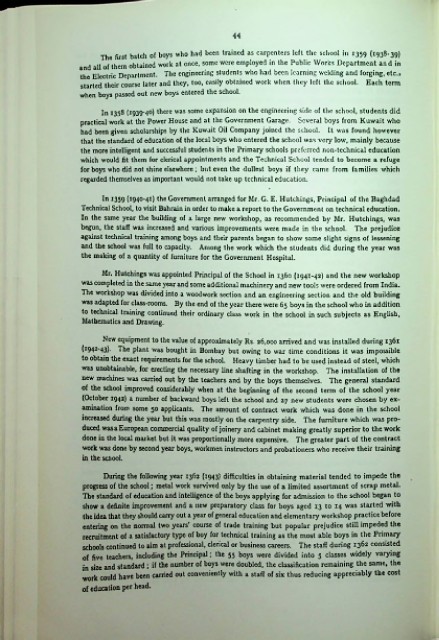Page 322 - Bahrain Gov Annual Reports (III)_Neat
P. 322
44
The first batch of boys who had been trained as carpenters left the school in 1359 (1938-39)
and all of them obtained work at once, some were employed in the Public Works Department and in
the Electric Department. The engineering students who had been learning welding and forging, etc.,
started their course later and they, too, easily obtained work when they left the school. Each term
when boys passed out new boys entered the school.
In 1358 (1939-40) there was some expansion on the engineering side of the school, students did
practical work at the Power House and at the Government Garage. Several boys from Kuwait who
had been given scholarships by the Kuwait Oil Company joined the school. It was found however
that the standard of education of the local boys who entered the school was very low, mainly because
the more intelligent and successful students in the Primary schools preferred non-technical education
which would fit them for clerical appointments and the Technical School tended to become a refuge
for boys who did not shine elsewhere; but even the dullest boys if they came from families which
regarded themselves as important would not take up technical education.
In 1359 (1940-41) the Government arranged for Mr. G. E. Hutchings, Principal of the Baghdad
Technical School, to visit Bahrain in order to make a report to the Government on technical education.
In the same year the building of a large new workshop, as recommended by Mr. Hutchings, was
begun, the staff was increased and various improvements were made in the school. The prejudice
against technical training among boys and their parents began to show some slight signs of lessening
and the school was full to capacity. Among the work which the students did during the year was
the making of a quantity of furniture for the Government Hospital.
Mr. Hutchings was appointed Principal of the School in 1360 (1941-42) and the new workshop
was completed in the same year and some additional machinery and new tools were ordered from India.
The workshop was divided into a woodwork section and an engineering section and the old building
was adapted for class-rooms. By the end of the year there were 65 boys in the school who in addition
to technical training continued their ordinary class work in the school in such subjects as English,
Mathematics and Drawing.
New equipment to the value of approximately Rs. 26,000 arrived and was installed during 1361
(1942-43). The plant was bought in Bombay but owing to war time conditions it was impossible
to obtain the exact requirements for the school. Heavy timber had to be used instead of steel, which
was unobtainable, for erecting the necessary line shafting in the workshop. The installation of the
new machines was carried out by the teachers and by the boys themselves. The general standard
of the school improved considerably when at the beginning of the second term of the school year
(October 1942) a number of backward boys left the school and 27 new students were chosen by ex
amination from some 50 applicants. The amount of contract work which was done in the school
increased during the year but this was mostly on the carpentry side. The furniture which was pro
duced wasaEuropean commercial quality of joinery and cabinet making greatly superior to the work
done in the local market but it was proportionally more expensive. The greater part of the contract
work was done by second year boys, workmen instructors and probationers who receive their training
in the school.
During the following year 1362 (1943) difficulties in obtaining material tended to impede the
progress of the school; metal work survived only by the use of a limited assortment of scrap metal.
The standard of education and intelligence of the boys applying for admission to the school began to
show a definite improvement and a new preparatory class for boys aged 13 to 14 was started with
the idea that they should carry out a year of general education and elementary workshop practice before
entering on the normal two years' course of trade training but popular prejudice still impeded the
recruitment of a satisfactory type of boy for technical training as the most able boys in the Primary
schools continued to aim at professional, clerical or business careers. The staff during 1362 consisted
of five teachers, including the Principal; the 55 boys were divided into 5 classes widely varying
in size and standard; if the number of boys were doubled, the classification remaining the same, the
work could have been carried out conveniently with a staff of six thus reducing appreciably the cost
of education per head.

